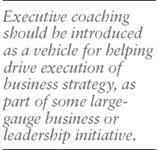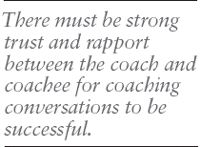Executive Coaching: Transforming Big Pharma from Within
Pharmaceutical Executive
Defining the critical coaching steps necessary for top managers to realize their potential in an industry undergoing significant restructuring of human and financial capital.
These are tumultuous times at the top ranks of the big Pharma c-suite. Changing customer models, a predatory M&A cycle, rising therapeutic competition, and cost containment spurred by consolidation in the payer base are forcing most companies to rethink their business and marketing strategies.
The first line of offense in addressing these challenges is an agile, adaptable, and responsive cadre of leaders: the CEO along with a senior management team with the ability to be strategic one moment and tactical the next; who can nurture other leaders in their organizations, and articulate new visions and business strategies on a regular basis. It's all about people who can function across many lines of business and geography, with a truly comprehensive perspective on the complex and often contradictory nature of today's global pharma business.

Photo: Thinkstock
Companies are incorporating coaching into their corporate leadership development programs, using these to grow leaders at every level. That's because they've come to realize the importance of grooming top managers who possess the right mix of critical industry skills and personal attributes (e.g., leadership agility, strong self-awareness, and adaptive capacity) necessary to be effective leaders in times of continuous change.
Companies are using coaching to:
» Facilitate and accelerate the onboarding of new executives, especially at senior levels.
» Help already strong corporate performers become truly stand-out performers.
» Prepare recently promoted executives for new job responsibilities.
» Position high-potential managers for future promotion.
» Help executives and managers at many levels develop the self-awareness required to manage and motivate people in today's global business environment.
Selecting managers best poised to benefit from coaching is but the first step in a long process. Who in your organization is an appropriate candidate for executive coaching? It could be an established leader whom the organization wants to retain, develop, and groom for future advancement to the c-suite. It could be a young, rising star in the organization, who's viewed as an emerging leader with tremendous potential to be a corporate superstar in the near-to-medium-term future. Or it could be someone who's viewed as a strong, technical asset to the organization, but who needs guidance and feedback to improve his or her "soft skills" and personal self-awareness in dealing with others.
An executive coach might be asked to help a senior executive become more effective at strategy development and execution, or to help a new manager learn how to effectively manage a virtual or multi-cultural team. He or she might be asked to help a newly-promoted executive learn to manage an expanded array of job responsibilities or become more adept at delegation, strategic decision-making, communication, or managing through influence. A coach might also be retained to help an executive lead a major change initiative or to help the executive learn how to manage relationships with key internal and external stakeholders.
Doing it right requires four things: strong sponsorship by the organization's senior leaders, careful review and selection of coaches, consideration of the range of coaching services to offer executives and managers, and appropriate matching of coaches to individual executives and managers ( "coachees").
Top leadership should emphasize the importance of executive coaching to organizational success. If you're thinking of introducing executive coaching into your organization, it's important that it be championed by the CEO. It should be introduced as a vehicle for helping drive execution of business strategy, as part of some large-gauge business or leadership initiative. When coaching is positioned within an organization this way—as a critical linkage to the success of the business —it sets the tone and expectation for what executive coaching is intended to do, and gives it a strong leadership stamp of approval.

Build a cadre of external coaches. As part of introducing coaching into an organization, it's important to build a base of expertise that your company is interested in making available to its executives and managers. The corporate HR department will, in many cases, have access to information about coaches in the local areas where a company operates. Look for coaches who have solid line-business experience as leaders themselves, advanced degrees in business or organization development, and who can relate personally to the challenges that today's business executives and managers face. As part of vetting coaches, the HR department should interview individuals to better understand their personal coaching approaches, their coaching philosophies, and the specific kinds of tools and assessments they use in their coaching engagements.
Decide on the scale of services to offer. Your company needs to decide what level(s) of coaching to offer executives and managers. Some companies, for example, offer a range of coaching options to individuals, based on seniority, specific job responsibilities, and other factors. Some limit coaching services to a stipulated number of meetings or hours over a certain period of time, typically six months to a year. In other cases, and particularly for senior executives, a company may offer a fuller range of coaching options that includes weekly meetings with a coach, administration of 360-degree assessments that are then used as the basis of initial coaching work, 24/7 coach availability, and "shadowing," where a coach travels with and observes a top executive in meetings with employees, other senior executives, and other stakeholders.
How the coaching process works
Once your company's coaching program has been put in place, coaching engagements typically follow a series of steps. Those steps include:
Step 1: Alignment meeting
Once a coach and coachee have been paired, it's critical that the HR department arrange a four-way meeting that includes the coach, coachee, the coachee's boss, and sometimes a representative of HR. These "alignment meetings" are designed to ensure that there is broad general agreement at the start of a coaching engagement as to what areas of focus the coaching will have. It should also be made clear that the specific subject matter discussed in one-on-one coaching meetings is confidential.
Step 2: The initial meeting between coach and coachee
In an initial coaching meeting, the coach normally outlines to the coachee what executive coaching is designed to do. The coach discusses with the coachee issues of confidentiality, accountability, and supervisor "report-backs" and together the two parties "contract" with one another for purposes of going forward.
As part of the contracting process, both parties make commitments to the other about the roles they will bring to the coaching process. Because coaching is best thought of as a "co-equal" process (an alliance of peers), the coachee must bring a willingness to discuss issues impacting his or her job performance and leadership of others, and be willing to invest time, energy, and attention to develop a coaching action plan with clear and concrete goals. For his/her part, the coach must bring curiosity, a willingness to ask probing questions, and the ability to challenge the coachee, when appropriate, to help that individual articulate a set of coaching objectives.
Step 3: Client assessment and goal setting
After contracting occurs, the coaching engagement begins in earnest. The coach typically queries the coachee about what his or her coaching goals are, and initiates the process of getting to know the coachee in more depth. In some cases, a coach will meet informally alone with a coachee's supervisor and sometimes with the coachee's direct reports, to further gather contextual information that can inform the coaching process.
Early conversations between coach and coachee often pivot around several core concerns:
» To what extent does the coachee feel aligned with the company's mission and values?
» To what degree does he/she understand its culture, politics, organizational dynamics, and history?
» To what extent does he/she feel aligned with his/her boss and colleagues?
» To what extent does his/her own management style match that of the boss and co-workers?
All these factors can directly influence an individual's success and effectiveness in an organization.

As conversations proceed over several coaching meetings, the coachee typically delineates four to six specific coaching goals he/she wants to pursue, given the organizational context in which the person works, and the nature of the position the individual currently holds.
Step 4: Determine measures of success
A key element in making executive coaching work is ensuring the coachee and coach agree on specific metrics that will be used to assess their coaching progress. Thus, a coachee who decides that one of his/her goals is to improve team leadership skills might decide to query their executive team about this at the start of the coaching process, and then again six months later. Or, a coachee who decides one of his/her coaching goals is to improve the clarity of the communications with their direct reports might agree to use data from a 360-degree narrative assessment conducted before coaching work begins, as a baseline for measuring progress with this goal six months after coaching begins.
Step 5: Create a coaching development plan
As the coach and coachee work to define development goals (and associated metrics and timeframes for accomplishing them), it's also important that the coachee develop a personal mission statement to drive their actions and shape their development plan. In addition, the coach and coachee need to pinpoint specific skill gaps in an executive or manager's background, and identify available training or leadership development (LD) programs that may be available to help address these skill gaps.
Today, there are many LD and continuous learning options that a company may want to make available to executives, based on needs determined in coaching discussions. For example, coaching may determine that a high-potential executive would benefit from a special set of rotational job assignments that expose him or her to other parts of the business, or that participation in a senior leadership program offered by a leading business school would help that person develop stronger skills in the areas of global strategy formulation, brand building, and business execution.
Step 6: Implement the plan
Once coaching goals have been established, timeframes for completion have been agreed to, and action steps initiated, it's important that the coach and coachee continue to meet on a regular basis to review progress in achieving goals, and to discuss issues of interest or challenge to the coachee as they arise. During this same phase of coaching, a coach will sometimes check in with a coachee's direct reports, or "shadow" his or her coachee, to see how the individual is applying ideas and principles discussed in coaching in real-life situations with employees and co-workers. Also during this phase, a coach may do role-plays with coachees as a way to address specific challenges.
Step 7: Evaluate progress and next steps
As coaching proceeds, it is clearly important for the coachee to provide feedback to the coach on how he/she feels the coaching is going.
» Is the coachee being successful in implementing his/her action goals?
» Does the coachee feel both supported and challenged?
» Has trust been firmly established, and is there good chemistry between the coach and coachee?
Because coaching relationships are co-equal, it's appropriate for the coach to occasionally ask the coachee for feedback, for example, by asking "Is the approach we're taking here helpful to you?" Good chemistry between coach and coachee is important because it creates momentum in the relationship, and binds the parties together in a mutual endeavor.
Step 8: Wrap-up — completing the formal coaching engagement
Most coaching engagements last from six to 12 months, sometimes longer. And they can involve different levels of service, depending on the seniority of a particular executive or the needs of a company or organization. That said, there comes a time when formal coaching engagements end; when the coachee has achieved good progress with their coaching goals, and structures have been put in place to evaluate continuing progress.
What makes coaching unique?
How is the coaching process different from traditional management consulting or training? Coaching differs from the latter function in several ways:
» At its core, executive coaching is a designed alliance between two equals—a "coachee" and a coach who work closely together over a specified period of time, typically six to 12 months. The goal of the relationship is to facilitate learning, personal growth, increased self-awareness, and achievement of specific professional or developmental goals in the executive or manager. The outcome of doing this is typically linked closely to improving a company's overall business performance, or aligning top leadership to promote better execution of business or organizational strategy.
» While executive coaches often bring specific subject-matter expertise and business-line experience to the coaching process, the principal role of a coach isn't to provide specific solutions or industry advice regarding business problems—as a consultant would do. Instead, it's to ask penetrating and powerful questions, to spark ideas and discussion, to challenge and engage the coachee, and to help generate insights and options in the mind of that individual that can create shifts in the person's thinking, awareness, and perspective, and help him or her more effectively deal with issues and challenges on the job. Such conversations become the basis for the coachee and coach to develop a leadership development or executive action plan, as well as specific metrics and timeframes for achieving performance goals.
» Unlike traditional training, the aim of which is to transfer hard skills or knowledge to executives and managers, executive coaching often focuses more on "people skills" development, and on helping technically talented managers and executives acquire a fuller understanding of their behavior, personal style, and impact on others. The development of "people skills" (e.g. emotional and social intelligence, right-brain thinking, strong self-awareness, etc.) traditionally has not been part of the curriculum at many business schools (though that is changing). Nor is it a topic that gets strong emphasis in many corporate training programs. Coaching, however, provides an ideal context in which this can occur.
» Target coaching efforts at your company's most important current and emerging leaders. Some people have the mistaken impression that coaching is primarily remedial in nature, offered to an executive who is derailing in their job or in danger of being fired or demoted. In reality, executive coaching is best thought of as a premium professional development offering that should only be extended to an organization's most vital and promising talent, as a way to support long-term success of the business.

That "T" factor
A final word: there must be strong trust and rapport between the coach and coachee for coaching conversations to be successful. Moreover, both parties to the relationship should come to an early consensus as to the scope of their coaching work, and the concrete goals that the coachee will strive to achieve.

Richard Koonce is a Director for the Ayers Group and co-author of Growing Leaders. He can be reached at Richard.koonce@ayers.com.

Addressing Disparities in Psoriasis Trials: Takeda's Strategies for Inclusivity in Clinical Research
April 14th 2025LaShell Robinson, Head of Global Feasibility and Trial Equity at Takeda, speaks about the company's strategies to engage patients in underrepresented populations in its phase III psoriasis trials.
Beyond the Prescription: Pharma's Role in Digital Health Conversations
April 1st 2025Join us for an insightful conversation with Jennifer Harakal, Head of Regulatory Affairs at Canopy Life Sciences, as we unpack the evolving intersection of social media and healthcare decisions. Discover how pharmaceutical companies can navigate regulatory challenges while meaningfully engaging with consumers in digital spaces. Jennifer shares expert strategies for responsible marketing, working with influencers, and creating educational content that bridges the gap between patients and healthcare providers. A must-listen for pharma marketers looking to build trust and compliance in today's social media landscape.

.png&w=3840&q=75)

.png&w=3840&q=75)



.png&w=3840&q=75)



.png&w=3840&q=75)
















